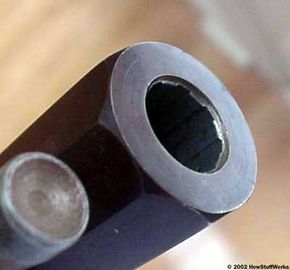The Barrel
The barrel of a flintlock is its own technological marvel, especially for the time. A blacksmith would take a flat piece of iron and beat it into a cylindrical shape around a mandrel -- a long rod of the proper diameter. By heating the iron to a high enough temperature in a forge, the blacksmith actually welded the seam along the length of the barrel to form a strong tube. This process could take days. Barrels ranged anywhere from pistol length (6 to 12 inches, 15 to 30 cm) to long gun length (40 to 60 inches, 102 to 152 cm).
The blacksmith could finish the interior of the barrel as either a smooth bore or a rifled bore. A smooth bore is just that -- smooth along the entire length of the barrel. The Brown Bess of the American Revolutionary War was smooth bored. So is any shotgun. Drilling out the tube with successively larger bits and then polishing with a reamer creates a smooth bore barrel.
Advertisement
Rifling a barrel is a way of increasing the accuracy of the bullet, whether the bullet is spherical or cone shaped. To rifle a barrel, you start with a smooth bore and engrave spiral grooves down the inside of the barrel. A typical pattern is one twist of the grooves in 48 inches (122 cm) of barrel length. As the bullet speeds down the barrel it engages the grooves, exiting the barrel with a rapid spin (between 1,000 and 3,000 RPM) and traveling at a speed of 1,000 to 2,000 feet per second (305 to 610 meters per second) through the air.
Once the barrel is smoothed or rifled, one end is closed off with a breech plug. Then, a small hole is drilled in the barrel to allow the flame from the flintlock's pan to enter the barrel and ignite the charge.
